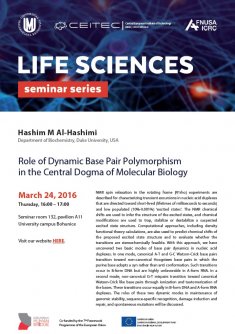Lunch in Campea Restaurant (Thursday at 12:00)
Abstract:
NMR spin relaxation in the rotating frame (R1rho) experiments are described for characterizing transient excursions in nucleic acid duplexes that are directed toward short-lived (lifetimes of milliseconds to seconds) and low populated (10%-0.001%) ‘excited states’. The NMR chemical shifts are used to infer the structure of the excited states, and chemical modifications are used to trap, stabilize or destabilize a suspected excited state structure. Computational approaches, including density functional theory calculations, are also used to predict chemical shifts of the proposed excited state structure and to evaluate whether the transitions are stereochemically feasible. With this approach, we have uncovered two basic modes of base pair dynamics in nucleic acid duplexes. In one mode, canonical A-T and G-C Watson-Crick base pairs transition toward non-canonical Hoogsteen base pairs in which the purine base adopts a syn rather than anti conformation. Such transitions occur in B-form DNA but are highly unfavorable in A-form RNA. In a second mode, non-canonical G-T mispairs transition toward canonical Watson-Crick like base pairs through ionization and tautomerization of the bases. These transitions occur equally in B-form DNA and A-form RNA duplexes. The roles of these two dynamic modes in maintenance of genomic stability, sequence-specific recognition, damage induction and repair, and spontaneous mutations will be discussed.
Hashim M Al-Hashimi
James B. Duke Professor of Biochemistry
Director, Duke Center for RNA Biology
Department of Biochemistry
Department of Chemistry
Duke University School of Medicine
Duke University
Office 228-B Nanaline H Duke Building
Office Tel: 919-660-1113 Lab Tel: 919-660-1114/5/6
Office mailing Address:
Box 3711
Nanaline H. Duke Building
307 Research Drive
Durham NC 27710
Lab mailing address:
Duke Medical Research Center
307 Research Dr., Box 3711
Nanaline Duke Bldg, RM 227
Durham, NC 27710-3025








